Dogs experience time very differently than humans. While an hour may drag or fly by for us, it feels much longer to our canine companions. Read on to learn how dogs perceive time and why it can seem to move so slowly for them.
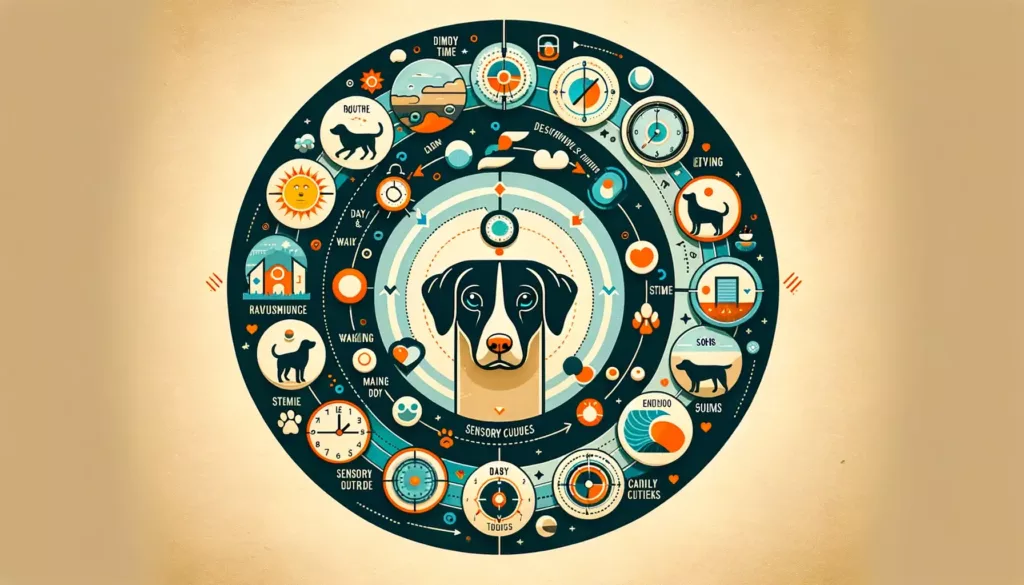
For humans, time is measured precisely in hours, minutes, and seconds. We structure our lives around calendars, clocks, and schedules. But for dogs, the concept of hourly time doesn’t really exist. Their experience of time is based on their senses, emotions, and perception of daily events. So while we may only be gone for 1 hour, it can feel like an eternity to our furry friends at home.
How Long is an Hour for a Dog?
- Dogs live in the present moment – They don’t dwell on the past or future like humans do. They are fully focused on what is happening right now.
- Routines shape their perception – Dogs recognize patterns and anticipate events based on daily routines like mealtimes and walks.
- Sensory cues influence them – Changes in light, smells, and sounds throughout the day help dogs sense the passage of time.
- Emotions impact them – Moments of anxiety or excitement seem to slow down or speed up time for dogs.
- Age affects them – Puppy energy makes time fly by, while senior dogs appreciate long naps. Breeds also perceive time differently.
So while dogs can’t measure time like we do, they have an incredible ability to adapt to our schedules and sense changes throughout the day. Their perception of time is fluid but tuned into the world around them.

Why Does Time Go By Slowly for Dogs?
How Long is an Hour for a Dog? Imagine you’re home alone, with no understanding of when your loved ones will return. Minutes crawl by endlessly. This is often how dogs experience being left alone at home. Some key reasons time drags on for dogs:
- They miss their humans – Pack animals by nature, dogs hate being isolated from their family. They don’t understand the reason.
- They’re bored – With no activities or mental stimulation, dogs have nothing to occupy their minds.
- They feel anxious – Changes in routine and isolation can trigger anxiety.
- They can’t track time – Without a human concept of time, they feel lost.
While every dog has a unique perception of time, most experience some distress when left alone for long periods. Signs like pacing, restlessness, and destruction often indicate they struggled with the passage of time.
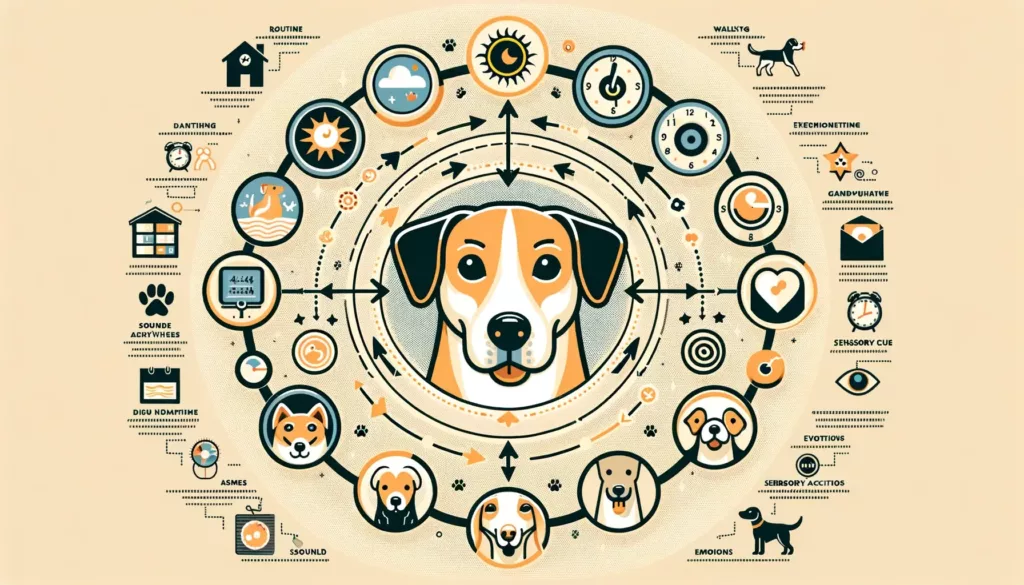
Tips for Making Time Go Faster for Your Dog
Here are some ways to help your dog feel more comfortable when left alone:
- Keep routines consistent – Sticking to regular schedules helps dogs anticipate your return.
- Provide puzzle toys – Keeping their mind active makes time pass more quickly.
- Play calming music – Soothing sounds help them relax.
- Arrange a comfy space – Cozy beds give dogs a sense of security.
- Exercise beforehand – Physical activity helps them feel tired and content.
- Use pheromone diffusers – These synthetic chemicals provide comfort.
- Ask a pet sitter to pop in – A mid-day visit reassures them.
While we can’t speed up time for our dogs, understanding their perception of it can lead to a happier life together. Pay attention to your pup’s signals when left alone and adjust your routines to ease their distress. With a little empathy for your dog’s experience of time, you can help make the hours fly by.
Key Takeaway :
- Dogs perceive time differently than humans, and an hour feels unique to them.
- Understanding a dog’s sense of time can help improve training and interactions.
- Explore how dogs experience the passage of time in various contexts.
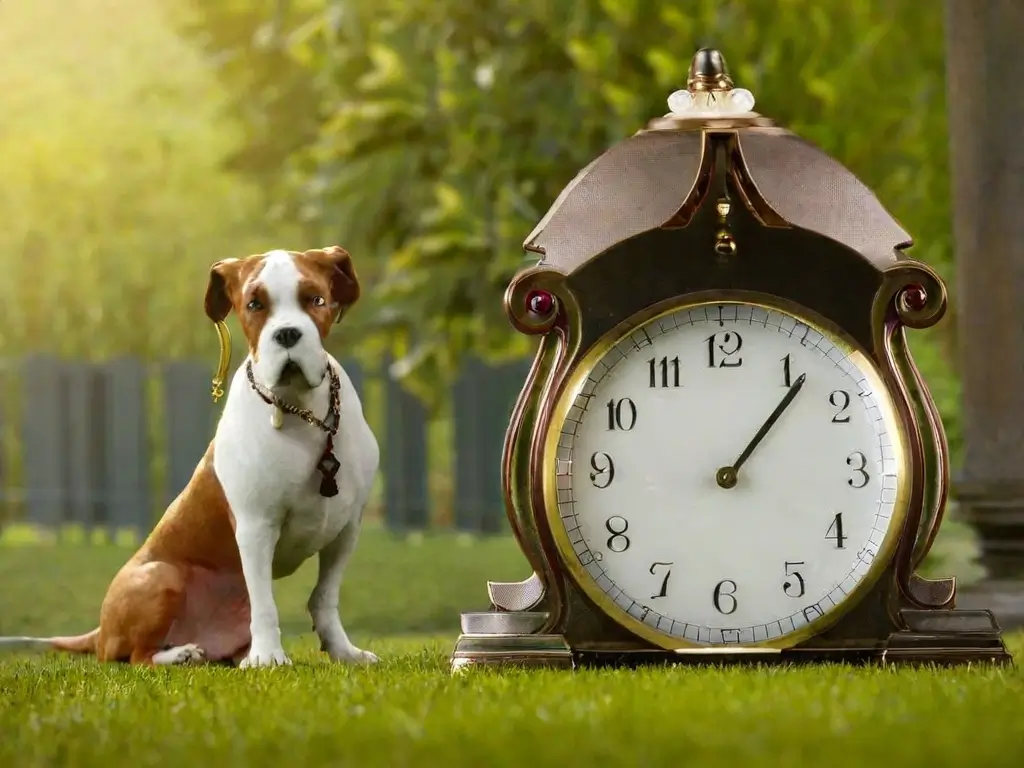
Time is a fundamental aspect of our lives, shaping our daily routines and experiences. For humans, an hour can pass by quickly during an engaging conversation or feel agonizingly slow during a tedious task. But have you ever wondered, how long is an hour for a dog? Do they perceive time in the same way we do? In this article, we delve into the fascinating world of canine time perception to uncover the unique ways our furry friends experience the passage of time.
Understanding how dogs perceive time is not just an intriguing topic; it has practical implications for dog owners. By gaining insight into our dogs’ time-related senses, we can tailor our interactions, training, and care to better meet their needs. So, let’s embark on this journey to explore what an hour feels like for a dog.

What is an Hour Like for a Dog?
To grasp a dog’s experience of an hour, we need to first consider their sensory perception. Unlike humans, dogs rely heavily on their acute senses of smell and hearing. These senses are finely tuned to the world around them, enabling them to pick up on scents and sounds that escape our notice.
For a dog, an hour may feel like a rich tapestry of sensory experiences. Imagine the scents that waft through the air during a leisurely walk in the park—the earthy aroma of the ground, the enticing scent of other animals, and the lingering traces of past visitors. These olfactory sensations create a vivid and ever-changing landscape for our canine companions.
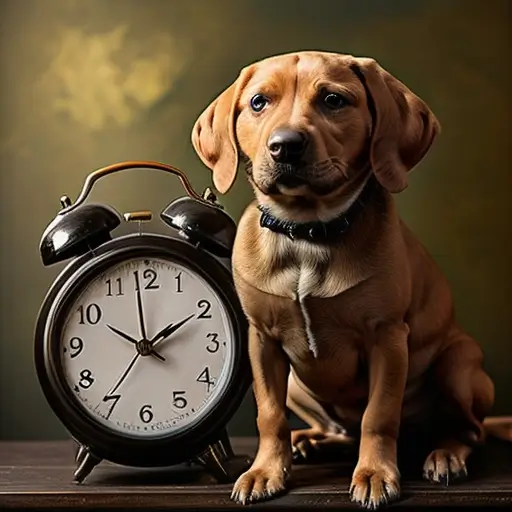
In addition to their keen sense of smell, dogs have exceptional hearing. They can detect sounds at frequencies that are beyond the range of human hearing. As a result, an hour for a dog may involve hearing distant car engines, the rustling of leaves, or the faintest chirp of a bird, all of which contribute to their perception of time.
Furthermore, a dog’s activities within an hour can vary greatly depending on their age, breed, and energy level. A playful puppy may spend the hour in a whirlwind of energetic play, while a senior dog might choose to snooze peacefully.
It’s important to note that a dog’s sense of time is likely not as linear as ours. They may not have a precise understanding of minutes and hours as we do. Instead, their perception of time may be more closely linked to their immediate environment and the activities they engage in.
Does an Hour Feel Short or Long to a Dog?
One of the intriguing aspects of a dog’s perception of time is whether an hour feels short or long to them. While we humans often lament how quickly time passes or how slowly it drags on, dogs have a different relationship with the ticking clock.

For many dogs, an hour can feel relatively short, especially when they’re engaged in activities they enjoy. Playtime with their favorite toys or a romp in the park can make an hour seem to fly by. This phenomenon is a testament to a dog’s boundless enthusiasm and ability to live in the present moment.
Conversely, an hour may feel longer to a dog when they’re left alone or are bored. Dogs are social animals, and they thrive on interaction with their human companions. When left without stimulation or company, they may become restless, and each minute can seem to stretch on indefinitely.
Factors like age, breed, and individual personality also play a role in a dog’s perception of time. High-energy breeds might pack more activities into an hour, making it seem shorter, while more laid-back breeds may find an hour to be a longer stretch of time.
Understanding how an hour feels to your specific dog can help you plan their daily routine more effectively. Ensuring they have mental and physical stimulation can prevent them from feeling anxious or frustrated during longer periods of time alone.
Do Dogs Have a Sense of Hourly Time?
Dogs are known for their remarkable ability to pick up on routines and patterns. Many dog owners have experienced their pets anticipating mealtime or recognizing the approach of their daily walk. But does this mean dogs have a genuine sense of hourly time?
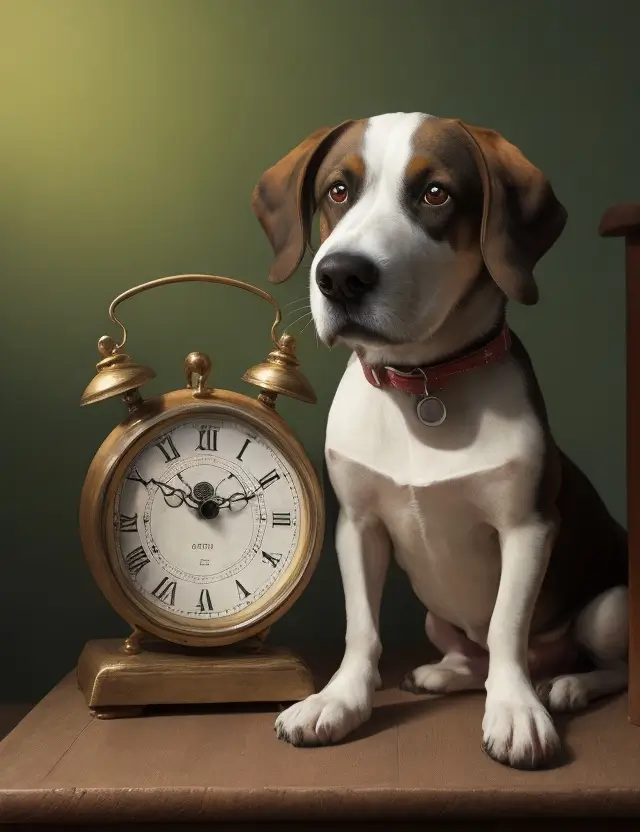
While dogs do exhibit a sense of routine, their perception of time is likely not as precise as ours. They may not comprehend the concept of an hour as a fixed unit of time. Instead, they rely on cues such as the position of the sun, the consistency of their daily routines, and the arrival of familiar people or events to understand the passage of time.
For instance, if you consistently feed your dog at the same time each day, they may start to associate certain cues, such as the sound of their food bowl, with mealtime. They can predict mealtime based on these cues, but it doesn’t necessarily mean they have a precise understanding of an hour.
Similarly, dogs may recognize the approach of evening, indicating that it’s time for their nightly walk. This recognition is often based on environmental changes, like the dimming of daylight, rather than an innate sense of hourly time.
In summary, while dogs are skilled at recognizing routines and cues, their perception of hourly time is likely more fluid and linked to their immediate environment and experiences. They may not have a concept of time in the same way humans do, but they can certainly adapt to our schedules and routines.
In the upcoming sections, we’ll explore how dogs perceive the passing of an hour and whether they can tell when an hour has gone by. We’ll also delve into the differences between a dog’s sense of time and a human’s, shedding light on the fascinating world of canine time perception.
How Do Dogs Perceive the Passing of an Hour?
Understanding how dogs perceive the passage of time can shed light on their unique perspective on the world. While dogs may not have a precise concept of hours and minutes, they have their ways of marking the passage of time.
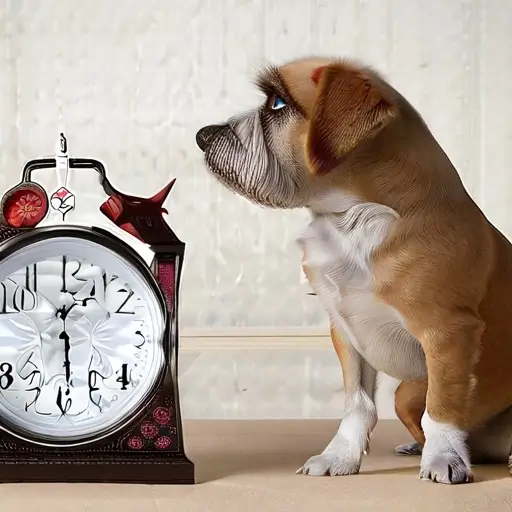
One way dogs perceive time is through their internal biological clocks. Just like humans, dogs have daily rhythms that dictate when they feel hungry, sleepy, or active. These rhythms are influenced by factors such as light, temperature, and social interactions.
For instance, your dog may start to get restless or show signs of anticipation around the time they usually go for a walk or receive a meal. This suggests that they have a sense of when these events should occur.
Dogs also rely on their senses to gauge the passage of time. They might notice changes in lighting as the day progresses, and these changes can signal transitions in their routine. As the sun sets, they may anticipate that it’s approaching bedtime or evening playtime.
Another way dogs perceive time is through their interactions with their human companions. Dogs are highly attuned to their owners’ behaviors and routines. If you typically come home from work at a certain time, your dog may start to get excited or wait by the door in anticipation.
In essence, while dogs may not have a strict grasp of hourly time like humans, they are masters at recognizing patterns, routines, and environmental cues. This keen perception allows them to adapt and anticipate events in their lives.
Is an Hour a Long Time for a Canine?
Whether an hour feels long or short to a dog depends on several factors, including their age, breed, and individual disposition.
For puppies and young dogs, an hour can feel relatively long, especially when they have a lot of pent-up energy. These playful pups may want to engage in various activities, and they can become restless when confined for extended periods. To them, an hour of playtime can be pure joy, while an hour of inactivity may seem never-ending.
On the other hand, senior dogs or breeds with lower energy levels may perceive an hour differently. They may be content with leisurely naps and shorter bursts of activity. For them, an hour of relaxation might pass quickly, and they may not have the same eagerness for extended play sessions.
It’s important for dog owners to gauge their individual dog’s needs and energy levels. By understanding how an hour feels to your specific canine companion, you can tailor their daily routines and activities accordingly.
In the following sections, we’ll delve deeper into whether dogs understand time in hours and whether 60 minutes feel fast or slow to a pup. We’ll also explore whether dogs can tell when an hour has gone by and how their sense of time compares to that of humans.
Do Dogs Understand Time in Hours? How Long is an Hour for a Dog?
Dogs don’t possess the same understanding of hours and minutes as humans do. Instead, they rely on their instincts, routines, and sensory perceptions to navigate their world. This means that dogs may not grasp the concept of time as a precise measurement. However, they have a remarkable ability to adapt to patterns and anticipate events.
For example, if you consistently take your dog for a walk at 7 AM every morning, they’ll come to expect it based on the routine and the cues in their environment, such as the sound of your alarm clock or the scent of their leash. While they may not know that it’s precisely 7 AM, they’ll certainly recognize that it’s time for their daily walk.
This adaptability is one of the reasons dogs make excellent companions. They can synchronize their activities with your daily schedule, making them easy to integrate into your life.
Does 60 Minutes Feel Fast or Slow to a Pup?
The perception of time can vary greatly between different life stages of dogs. Puppies, known for their boundless energy and curiosity, may find 60 minutes to be a relatively long time. They’re eager to explore the world and engage in play, and an hour of these activities can pass by in a flash.
On the other hand, older dogs, especially senior dogs, may find 60 minutes to be a more manageable stretch of time. They tend to appreciate longer periods of rest and may not require as much stimulation.
Furthermore, individual differences among dogs play a significant role in how they perceive time. Some dogs are naturally more patient and content, while others may become restless more quickly. Breed traits also contribute to these differences, with some breeds having higher energy levels and shorter attention spans than others.
As a dog owner, it’s essential to understand your specific dog’s needs and preferences when it comes to time management. Tailoring their daily routines to align with their unique perception of time can lead to a happier and more fulfilling life for both you and your furry companion.
Dog Time Perception by Age
| Age | Perception of 60 Minutes |
|---|---|
| Puppy | Feels relatively long; filled with play and exploration. |
| Adult | Perception varies by breed and individual temperament. |
| Senior | May feel more manageable; appreciates longer rest periods. |
In the upcoming sections, we’ll explore whether dogs can tell when an hour has gone by and how a dog’s sense of time compares to that of humans.
Can Dogs Tell When an Hour Has Gone By?
While dogs may not possess a precise understanding of hours and minutes, they are surprisingly adept at recognizing patterns and routines. This means that dogs can often tell when a significant amount of time has passed, even if they can’t measure it in hours.
For example, if you leave your dog alone every weekday for a set amount of time while you’re at work, they may learn to anticipate your return based on these patterns. They can pick up on cues such as the sound of your car pulling into the driveway or the consistent timing of your arrival. These cues signal to them that a certain amount of time has passed.
Additionally, dogs can sense changes in their environment that occur over time, such as the shift from day to night. These changes can help them gauge the passage of time to some extent.
However, it’s important to note that a dog’s perception of time is more flexible and context-dependent than our human concept of hourly time. They may not know precisely when an hour has passed, but they can sense changes and anticipate events based on their routines and sensory cues.
How Does a Dog’s Sense of Time Compare to Humans?
A dog’s sense of time is fundamentally different from that of humans. While humans have a highly developed understanding of hours, minutes, and seconds, dogs rely on their instincts and sensory perceptions to navigate their world.
Humans can accurately measure time using clocks and calendars, making appointments, and keeping track of schedules. Dogs, on the other hand, don’t have this capability. Instead, they rely on their keen senses of smell and hearing, as well as their instincts, to understand the passage of time in a more fluid and adaptable manner.
One significant difference is that dogs live in the present moment. They don’t dwell on the past or future as humans often do. This presence in the here and now is one of the reasons dogs can be such wonderful companions, as they can fully engage in the present moment.
In summary, while dogs may not understand time in the same precise way humans do, they have their unique ways of perceiving and adapting to the passage of time. Their sense of time is influenced by their environment, routines, and sensory perceptions, allowing them to thrive in the world alongside their human companions.
FAQs: How Dogs Perceive Time
- Q: Do dogs understand the concept of hours and minutes like humans do?
- A: No, dogs do not have a precise understanding of hours and minutes. They perceive time differently, relying on their instincts, routines, and sensory perceptions.
- Q: Can dogs tell when an hour has passed?
- A: Dogs can recognize patterns and routines, so they may anticipate events or your return based on consistent cues. However, they don’t measure time in the same way humans do.
- Q: How do dogs sense changes in time, such as day turning into night?
- A: Dogs can detect changes in their environment, such as light levels, temperature, and sounds. These changes help them gauge the passage of time to some extent.
- Q: Does a dog’s age affect their perception of time?
- A: Yes, a dog’s age can influence how they perceive time. Puppies may find an hour of playtime exciting, while senior dogs may appreciate longer periods of rest.
- Q: Are certain dog breeds better at understanding time than others?
- A: A dog’s perception of time varies more by individual temperament than by breed. However, some breeds are naturally more active and may have shorter attention spans.
- Q: How can I help my dog adapt to my daily schedule?
- A: Establishing consistent routines and providing sensory cues, such as feeding at the same time each day, can help your dog adapt to your schedule.
- Q: Is it essential to maintain a regular routine for my dog’s well-being?
- A: While dogs thrive on routines, occasional variations in their schedule are generally fine. Dogs are adaptable and can adjust to changes.
- Q: Can I use a clock or timer to help my dog understand time better?
- A: Dogs do not comprehend time as humans do, so using a clock or timer is unlikely to help them understand time in a traditional sense.
- Q: Do dogs perceive time differently during moments of anxiety or excitement?
- A: Yes, during moments of heightened emotion, dogs may have a different perception of time. They may feel that time either slows down or speeds up.
- Q: Why do some dogs seem to know when it’s time for specific events, like mealtime or walks?
- A: Dogs recognize patterns and cues associated with these events, such as the sound of their food bowl or the sight of their leash.
- Q: Can dogs remember past events and experiences as a way of measuring time?
- A: While dogs have a form of memory, it’s not used to measure time. They primarily rely on immediate sensory cues and routines.
- Q: Is there a way to help my dog manage their perception of time during my absence?
- A: Providing mental and physical stimulation through toys, puzzles, or a comfortable environment can help your dog cope with your absence.
- Q: Do dogs have a sense of urgency when they need to go outside to relieve themselves?
- A: Yes, dogs may exhibit signs of urgency when they need to go outside. This behavior is driven by their instincts and bodily needs.
- Q: Can my dog experience boredom or loneliness if left alone for an extended period?
- A: Yes, dogs can experience boredom and loneliness during prolonged periods of isolation. They thrive on social interaction and mental stimulation.
- Q: How can understanding my dog’s perception of time improve our relationship?
- A: Understanding your dog’s perception of time can help you tailor their routines and activities, leading to a more fulfilling and harmonious bond between you and your furry companion.
Hi, I’m John and I love dogs. Ever since I was a kid, I always wanted to have a furry friend by my side. I grew up with a golden retriever named Max, who taught me a lot about loyalty, friendship, and fun. He was my best buddy for 12 years, and I miss him every day.
